The Shifting Baseline Syndrome and Generational Amnesia in Heritage Studies
Abstract
1. Introduction
Heritage Processes
2. Material and Methods
2.1. Approach
2.2. The Concept of the Shifting Baseline Syndrome
2.3. The Application of the Shifting Baseline Syndrome Outside Ecological Research
3. Results
3.1. The Role of the Shifting Baseline Syndrome in Relation to Moveable Heritage
3.1.1. Example: Vintage Cars
3.1.2. Example: Stamp Collecting
3.1.3. Example: Telephone Cards
3.2. Defining Generations
3.3. Lived Experience and Generational Memory
4. Discussion
4.1. The Shifting Baseline Syndrome in Heritage Site Identification
Example: Crawford’s Coach Stables, Albury, New South Wales
4.2. The Shifting Baseline Syndrome in Heritage Site Listing Processes
5. Discussion
6. Conclusions
Funding
Institutional Review Board Statement
Data Availability Statement
Conflicts of Interest
References
- Smith, L. Uses of Heritage; Routledge: Abingdon, UK, 2006. [Google Scholar]
- UNESCO. Basic Texts of the 2003 Convention for the Safeguarding of Intangible Cultural Heritage’ for Its Protection and Promotion; UNESCO: Paris, France, 2020. [Google Scholar]
- Howard, K. Music as Intangible Cultural Heritage: Policy, Ideology, and Practice in the Preservation of East Asian Traditions; Routledge: London, UK, 2016. [Google Scholar]
- Parker, M.; Spennemann, D.H.R. Stille Nacht: COVID and the ghost of Christmas 2020. Heritage 2021, 4, 3081–3097. [Google Scholar] [CrossRef]
- Sandell, R. Museums as agents of social inclusion. Mus. Manag. Curatorship 1998, 17, 401–418. [Google Scholar] [CrossRef]
- Spennemann, D.H.R. Beyond “Preserving the Past for the Future”: Contemporary Relevance and Historic Preservation. CRM J. Herit. Steward. 2011, 8, 7–22. [Google Scholar]
- Australia ICOMOS. The Burra Charter. The Australia ICOMOS Charter for Places of Cultural Significance 2013; Australia ICOMOS Inc. International Council of Monuments and Sites: Burwood, VIC, Australia, 2013. [Google Scholar]
- de la Torre, M. Values and heritage conservation. Herit. Soc. 2013, 6, 155–166. [Google Scholar] [CrossRef]
- Silberman, N. Changing visions of heritage value: What role should the experts play? Ethnologies 2014, 36, 433–445. [Google Scholar] [CrossRef]
- Fredheim, L.H.; Khalaf, M. The significance of values: Heritage value typologies re-examined. Int. J. Her. Stud. 2016, 22, 466–481. [Google Scholar] [CrossRef]
- Hawke, S.K. Sense of place in changing communities: The plurality of heritage values. In Proceedings of the ICOMOS Scientific Symposium Dublin Castle, Dublin, Ireland, 30 October 2010; p. 37. [Google Scholar]
- Jones, S. Wrestling with the Social Value of Heritage: Problems, Dilemmas and Opportunities. J. Commun. Archaeol. Herit. 2017, 4, 21–37. [Google Scholar] [CrossRef]
- Spennemann, D.H.R. The Nexus between Cultural Heritage Management and the Mental Health of Urban Communities. Land 2022, 11, 304. [Google Scholar] [CrossRef]
- Spennemann, D.H.R. Futurist rhetoric in U.S. historic preservation: A review of current practice. Int. Rev. Public Nonprofit Mark. 2007, 4, 91–99. [Google Scholar]
- Özçakır, Ö.; Bilgin Altınöz, A.G.; Mignosa, A. A tool for identifying post-Intervention value shifts in urban heritage places: The Heritage Value Circle. J. Archit. Conserv. 2021, 28, 1–24. [Google Scholar] [CrossRef]
- Morris, B. Aspiring to Greatness with Hindsight and Foresight: Assessing Current Preservation and Conservation Practices of Art Museum Library Collections. Art Doc. J. Art Libr. Soc. N. Am. 2019, 38, 95–121. [Google Scholar] [CrossRef]
- Murtagh, W.J. Keeping Time: The History and Theory of Preservation in America; John Wiley and Sons: New York, NY, USA, 1997. [Google Scholar]
- Spennemann, D.H.R. The Ethics of treading on Neil Armstrong’s Footprints. Space Policy 2004, 20, 279–290. [Google Scholar] [CrossRef]
- Spennemann, D.H.R. COVID-19 on the ground: Heritage sites of a pandemic. Heritage 2021, 3, 2140–2162. [Google Scholar] [CrossRef]
- Spennemann, D.H.R. Of Great Apes and Robots: Considering the Future(s) of Cultural Heritage. Futures 2007, 39, 861–877. [Google Scholar] [CrossRef]
- Gorman, A. The Anthropocene in the solar system. J. Contemp. Archaeol. 2014, 1, 87–91. [Google Scholar] [CrossRef]
- Gorman, A. The cultural landscape of interplanetary space. J. Soc. Archaeol. 2005, 5, 85–107. [Google Scholar] [CrossRef]
- Pétursdóttir, Þ. Concrete matters: Ruins of modernity and the things called heritage. J. Soc. Archaeol. 2013, 13, 31–53. [Google Scholar] [CrossRef]
- Pendlebury, J. Preserving Post-War Heritage: The Care and Conservation of Mid-Twentieth-Century Architecture. Town Plan. Rev. 2002, 73, 366. [Google Scholar]
- Rocha, L.; Fernandes Póvoas, R. Contemporary Challenges of Residential Buildings from Mid-twentieth Century: For a Renewed Consciousness of Heritage Preservation and Energy Sustainability. In Proceedings of the International Conference on Protection of Historical Constructions, Athens, Greece, 25–27 October 2021; pp. 1344–1358. [Google Scholar]
- Humphries, P.; Winemiller, K.O. Historical impacts on river fauna, shifting baselines, and challenges for restoration. Bioscience 2009, 59, 673–684. [Google Scholar] [CrossRef]
- Laurich, B.; Drake, C.; Gorman, O.T.; Irvine, C.; MacLaurin, J.; Chartrand, C.; Hebert, C.E. Ecosystem change and population declines in gulls: Shifting baseline considerations for assessing ecological integrity of protected areas. J. Gt. Lakes Res. 2019, 45, 1215–1227. [Google Scholar] [CrossRef]
- Vera, F. The shifting baseline syndrome in restoration ecology. In Restoration and History; Routledge: London, UK, 2010; pp. 116–128. [Google Scholar]
- Guerrero-Gatica, M.; Aliste, E.; Simonetti, J.A. Shifting gears for the use of the shifting baseline syndrome in ecological restoration. Sustainability 2019, 11, 1458. [Google Scholar] [CrossRef]
- Parsons, D.M.; Morrison, M.A.; MacDiarmid, A.B.; Stirling, B.; Cleaver, P.; Smith, I.W.G.; Butcher, M. Risks of shifting baselines highlighted by anecdotal accounts of New Zealand’s snapper (Pagrus auratus) fishery. N. Zldn. J. Mar. Freshw. Res. 2009, 43, 965–983. [Google Scholar] [CrossRef]
- Newsome, S.D.; Etnier, M.A.; Gifford-Gonzalez, D.; Phillips, D.L.; Van Tuinen, M.; Hadly, E.A.; Costa, D.P.; Kennett, D.J.; Guilderson, T.P.; Koch, P.L. The shifting baseline of northern fur seal ecology in the northeast Pacific Ocean. Proc. Natl. Acad. Sci. USA 2007, 104, 9709–9714. [Google Scholar] [CrossRef] [PubMed]
- van Zanden, J.L. Birds in Texel in 1910 and the shifting baseline syndrome. In Navigating History: Economy, Society, Knowledge, and Nature; Brill: Leiden, The Netherlands, 2017; pp. 317–327. [Google Scholar]
- Wu, T.; Petriello, M.A.; Kim, Y.-S. Shifting baseline syndrome as a barrier to ecological restoration in the American Southwest. Ecol. Restor. 2011, 29, 213–215. [Google Scholar] [CrossRef]
- Pauly, D. Anecdotes and the shifting baseline syndrome of fisheries. Trends Ecol. Evol. 1995, 10, 430. [Google Scholar] [CrossRef]
- Soga, M.; Gaston, K.J. Shifting baseline syndrome: Causes, consequences, and implications. Front. Ecol. Environ. 2018, 16, 222–230. [Google Scholar] [CrossRef]
- Pauly, D. Importance of the historical dimension in policy and management of natural resource systems. ACP-EU Fish. Res. Rep. 2001, 8, 5–10. [Google Scholar]
- Helson, H. Adaptation-level as a basis for a quantitative theory of frames of reference. Psychol. Rev. 1948, 55. [Google Scholar] [CrossRef]
- Russell, J.A.; Lanius, U.F. Adaptation level and the affective appraisal of environments. J. Environ. Psychol. 1984, 4, 119–135. [Google Scholar] [CrossRef]
- Evans, G.W.; Jacobs, S.V.; Frager, N.B. Adaptation to air pollution. J. Environ. Psychol. 1982, 2, 99–108. [Google Scholar] [CrossRef]
- Hanazaki, N.; Herbst, D.F.; Marques, M.S.; Vandebroek, I. Evidence of the shifting baseline syndrome in ethnobotanical research. J. Ethnobiol. Ethnomed. 2013, 9, 1–11. [Google Scholar] [CrossRef]
- Craig, R.K. The Regulatory Shifting Baseline Syndrome: Vaccines, Generational Amnesia, and the Shifting Perception of Risk in Public Law Regimes. Yale J. Health Policy Law Ethics 2022, 21. [Google Scholar] [CrossRef]
- Craig, R.K. The Regulatory Shifting Baseline Syndrome: Public Law as Cultural Memory. Utah Law Fac. Scholarsh. 2021, 301. [Google Scholar] [CrossRef]
- Rost, D. Shifting Baselines: Interdisciplinary Perspectives on Long-Term Change Perception and Memory; Institute for Advanced Study in the Humanities: Essen, Germeny, 2018. [Google Scholar]
- Belk, R.W. Collecting as luxury consumption: Effects on individuals and households. In Collectible Investments for the High Net Worth Investor; Elsevier: Amsterdam, The Netherlands, 2009; pp. 73–84. [Google Scholar]
- Apostolou, M. Why men collect things? A case study of fossilised dinosaur eggs. J. Econ. Psychol. 2011, 32, 410–417. [Google Scholar] [CrossRef]
- Carey, C. Modeling collecting behavior: The role of set completion. J. Econ. Psychol. 2008, 29, 336–347. [Google Scholar] [CrossRef]
- Shanaev, S.; Shimkus, N.; Ghimire, B.; Sharma, S. Children’s toy or grown-ups’ gamble? LEGO sets as an alternative investment. J. Risk Financ. 2020, 21, 577–620. [Google Scholar] [CrossRef]
- Knott, J.W. The ‘conquering car’: Technology, symbolism and the motorisation of Australia before World War II. Aust. Hist. Stud. 2000, 31, 1–26. [Google Scholar] [CrossRef]
- Greenwood, J. Driving through history: The car, the open road, and the making of history tourism in Australia, 1920–1940. J. Tour. Hist. 2011, 3, 21–37. [Google Scholar] [CrossRef]
- Thoms, D.; Holden, L. The Motor Car and Popular Culture in the Twentieth Century; Routledge: London, UK, 2016. [Google Scholar]
- Cross, G.S. Machines of Youth: America’s Car Obsession; University of Chicago Press: Chicago, IL, USA, 2018. [Google Scholar]
- Burton, B.J.; Jacobsen, J.P. Measuring returns on investments in collectibles. J. Econ. Perspect. 1999, 13, 193–212. [Google Scholar] [CrossRef]
- Martin, S.G. The road less traveled: The case for collectible automobiles as an asset class. J. Wealth Manag. 2016, 19, 131–139. [Google Scholar] [CrossRef]
- Lucsko, D.N. “Junkyard Jamboree”: Hunting for Automotive Treasure in the Twentieth Century. IA. J. Soc. Ind. Archeol. 2013, 39, 93–111. [Google Scholar]
- Lucsko, D.N. Junkyards, Gearheads, and Rust: Salvaging the Automotive Past; JHU Press: Baltimore, MD, USA, 2016. [Google Scholar]
- Ewing, M.T.; Wagstaff, P.E.; Powell, I.H. Brand rivalry and community conflict. J. Bus. Res. 2013, 66, 4–12. [Google Scholar] [CrossRef]
- Bedwell, S. Holden V Ford: The Cars, the Culture, the Competition; ReadHowYouWant: Sydney, Australia, 2012. [Google Scholar]
- Muniz, A.M.; O’guinn, T.C. Brand community. J. Consum. Res. 2001, 27, 412–432. [Google Scholar] [CrossRef]
- Fuller, G. “V8’s’ til’98” The V8 engine, Australian nationalism and automobility. Glob. Media J. Aust. Ed. 2012, 6, 1–11. [Google Scholar]
- Lucsko, D.N. Of clunkers and Camaros: Accelerated vehicle retirement programs and the automobile enthusiast, 1990–2009. Technol. Cult. 2014, 55, 390–428. [Google Scholar] [CrossRef]
- Simpson, C. Philately as a Hobby for Medical Men. Hospital 1912, 52, 302. [Google Scholar] [PubMed]
- Gibbons, E.S. The VR Illustrated Postage Stamp Album and Catalogue; Stanley Gibbons & Company: Saint Helier, UK, 1870. [Google Scholar]
- Tiffany, J.K. The Philatelical Library: A Catalogue of Stamp Publications; Privately printed: London, UK, 1874. [Google Scholar]
- Reed, B.D. Philately and the Teaching of Modern History. History 1923, 7, 266–273. [Google Scholar] [CrossRef]
- Proctor, N. Philately and geography teaching. Geography 1965, 50, 134–141. [Google Scholar]
- Baron, N.S. Letters by phone or speech by other means: The linguistics of email. Lang. Commun. 1998, 18, 133–170. [Google Scholar] [CrossRef]
- Babai, L. E-mail and the unexpected power of interaction. In Proceedings of the Fifth Annual Structure in Complexity Theory Conference, Barcelona, Spain, 8–11 July 1990; pp. 30–44. [Google Scholar]
- Falch, M.; Henten, A. Universal service in a digital world: The demise of postal services. In Proceedings of the 22nd Biennial Conference of the International Telecommunications Society (ITS): “Beyond the Boundaries: Challenges for Business, Policy and Society”, Seoul, Korea, 24–27 June 2018. [Google Scholar]
- Houck, A.C. Life After Volume Declines: Is There a Viable Future for the Postal Sector? In The Contribution of the Postal and Delivery Sector; Springer: Berlin/Heidelberg, Germany, 2018; pp. 161–173. [Google Scholar]
- Ramsey, A. The Development of Postal Franking Machines. Trans. Newcom. Soc. 1951, 28, 89–104. [Google Scholar] [CrossRef]
- Zeigler, R. Collecting Insights: Pluses and Minuses Concerning the Future of Philately. Available online: https://stamps.org/news/c/collecting-insights/cat/opinion/post/pluses-and-minuses-concerning-the-future-of-philately (accessed on 20 May 2022).
- Puri, V. Smart cards-the smart way for the banks to go? Int. J. Bank Mark. 1997, 15, 134–139. [Google Scholar] [CrossRef]
- Colnect. Telefonkartenkatalog–Jahresliste. Available online: https://colnect.com/de/phonecards/years (accessed on 20 May 2022).
- Michel. Telefonkarten-Katalog Deutschland 1993; Schwaneberger Verlag: München, Germany, 1993. [Google Scholar]
- Cant, M.A.; Johnstone, R.A. Reproductive conflict and the separation of reproductive generations in humans. Proc. Natl. Acad. Sci. USA 2008, 105, 5332–5336. [Google Scholar] [CrossRef]
- Connolly, J. Generational conflict and the sociology of generations: Mannheim and Elias reconsidered. Theory Cult. Soc. 2019, 36, 153–172. [Google Scholar] [CrossRef]
- Pilcher, J. Mannheim’s sociology of generations: An undervalued legacy. Br. J. Sociol. 1994, 45, 481–495. [Google Scholar] [CrossRef]
- Mukherjee, D.; Das, S.; Banik, S.D. Trends of consanguineous marriages in a Sunni Muslim population of West Bengal, India. Anthropol. Anz. 2007, 65, 253–262. [Google Scholar] [CrossRef] [PubMed]
- Nancy, H. Demography of the Dobe! Kung, 3rd ed.; Routledge: Abingdon, UK, 2017. [Google Scholar]
- Tremblay, M.; Vézina, H. New estimates of intergenerational time intervals for the calculation of age and origins of mutations. Am. J. Hum. Genet. 2000, 66, 651–658. [Google Scholar] [CrossRef] [PubMed]
- Pattison, J.E. Estimating inbreeding in large, semi-isolated populations: Effects of varying generation lengths and of migration. Am. J. Hum. Biol. 2007, 19, 495–510. [Google Scholar] [CrossRef]
- Ruggles, S. The effects of demographic change on multigenerational family structure: United States whites 1880–1980. In Les Systèmes Demographiques du Passé; Bideau, A., Perrenoud, A., Lynch, K.A., Brunet, G., Eds.; Centre Jacques Cartier: Lyons, France, 1996; pp. 21–40. [Google Scholar]
- Fenner, J.N. Cross-cultural estimation of the human generation interval for use in genetics-based population divergence studies. Am. J. Phys. Anthropol. 2005, 128, 415–423. [Google Scholar] [CrossRef] [PubMed]
- Helgason, A.; Hrafnkelsson, B.; Gulcher, J.R.; Ward, R.; Stefánsson, K. A populationwide coalescent analysis of Icelandic matrilineal and patrilineal genealogies: Evidence for a faster evolutionary rate of mtDNA lineages than Y chromosomes. Am. J. Hum. Genet. 2003, 72, 1370–1388. [Google Scholar] [CrossRef] [PubMed]
- Jorion, P. Matrilateral cross-cousin marriage in Australia. Soc. Sci. Inf. 1993, 32, 133–146. [Google Scholar] [CrossRef]
- Goldstein, J.; Lutz, W.; Scherbov, S. Long-Term Population Decline in Europe: The Relative Importance of Tempo Effects and Generational Length. Popul. Dev. Rev. 2003, 29, 699–707. [Google Scholar] [CrossRef][Green Version]
- Stephens, A.S.; Gupta, L.; Thackway, S.; Broome, R.A. Socioeconomic, remoteness and sex differences in life expectancy in New South Wales, Australia, 2001–2012: A population-based study. BMJ Open 2017, 7, e013227. [Google Scholar] [CrossRef]
- Page, A.; Begg, S.; Taylor, R.; Lopez, A.D. Global comparative assessments of life expectancy: The impact of migration with reference to Australia. Bull. World Health Organ. 2007, 85, 474–481. [Google Scholar] [PubMed]
- ABS. Life Tables. Statistics about Life Tables for Australia, States and Territories and Life Expectancy at Birth Estimates for Sub-State Regions. Reference Period 2018–2020. Available online: https://www.abs.gov.au/statistics/people/population/life-tables/latest-release (accessed on 22 May 2022).
- Trovato, F.; Lalu, N. Changing sex differences in life expectancy in Australia between 1970 and 1990. J. Aust. Popul. Assoc. 1997, 14, 187–200. [Google Scholar] [CrossRef] [PubMed]
- Preston, S.H.; Kevfitz, N.; Schoen, R. Causes of Death. Life Tables for National Populations; Seminar Press: New York, NY, USA, 1972. [Google Scholar]
- Taylor, R.; Lewis, M.; Powles, J. The Australian mortality decline: All-cause mortality 1788–1990. Aust. N. Zldn. J. Public Health 1998, 22, 27–36. [Google Scholar] [CrossRef] [PubMed]
- Taylor, R.; Salkeld, G. Health care expenditure and life expectancy in Australia: How well do we perform? Aust. N. Zldn. J. Public Health 1996, 20, 233–240. [Google Scholar] [CrossRef]
- ABS. Australian Social Trends: Life Expectancy Trends, March 2011; ABS 4102.0; Australian Bureau of Statistics: Canberra, Australia, 2011. [Google Scholar]
- Strauss, W.; Howe, N. Generations: The History of America’s Future, 1584 to 2069; Quill: New York, NY, USA, 1991. [Google Scholar]
- Rahman, F.; Tomlinson, D. Cross Countries: International Comparisons of Intergenerational Trends; Luxembourg Income Study: Luxembourg, 2018. [Google Scholar]
- Inayatullah, S. Future Avoiders, Migrants and Natives. J. Future Stud. 2004, 9, 83–86. [Google Scholar]
- Bickford, A. The patina of nostalgia. Aust. Archaeol. 1981, 13, 1–7. [Google Scholar] [CrossRef]
- Lowenthal, D. The Past is a Foreign Country; Cambridge University Press: Cambridge, UK, 1985. [Google Scholar]
- Lowenthal, D. The Past is a Foreign Country-Revisited; Cambridge University Press: Cambridge, UK, 2015. [Google Scholar]
- Monteiro, V.; Painho, M.; Vaz, E. Is the heritage really important? A theoretical framework for heritage reputation using citizen sensing. Habitat Int. 2015, 45, 156–162. [Google Scholar] [CrossRef]
- Nelson, K.; Fivush, R. The emergence of autobiographical memory: A social cultural developmental theory. Psychol. Rev. 2004, 111, 486. [Google Scholar] [CrossRef] [PubMed]
- Nelson, K. Narrative and self, myth and memory: Emergence of the cultural self. In Autobiographical Memory and the Construction of a Narrative Self: Developmental and Cultural Perspectives; Fivush, R., Haden, C.A., Eds.; Routlegde: Abingdon, Australia, 2003; pp. 3–28. [Google Scholar]
- Schacter, D.L. Searching for Memory: The Brain, the Mind, and the Past; Basic Books: New York, NY, USA, 1996. [Google Scholar]
- Assmann, J. Communicative and cultural memory. In The Theoretical Foundations of Hungarian ‘Lieux de Mémoire’ Studies; Varga, P.S., Katschthaler, K., Morse, D.E., Takács, M., Eds.; Debrecen University Press: Debrecen, Hungary, 2013; pp. 36–43. [Google Scholar]
- Assmann, J. Communicative and cultural memory. In Cultural Memory Studies. An International and Interdisciplinary Handbook,, New York 2008, S.; Erll, A., Nünning, A., Eds.; Springer: Berlin/Heidelberg, Germany; New York, NY, USA, 2008; pp. 109–118. [Google Scholar]
- Schütz, A. Life forms and meaning structures. In Alfred Schutz, Collected Papers VI. Literary Reality and Relationships; Wagner, H., Ed.; Springer Science & Business Media: Berlin/Heidelberg, Germany, 2013; pp. 37–115. [Google Scholar]
- Nagata, D.K.; Kim, J.H.; Nguyen, T.U. Processing cultural trauma: Intergenerational effects of the Japanese American incarceration. J. Soc. Issues 2015, 71, 356–370. [Google Scholar] [CrossRef]
- Gu, X.; Tse, C.-S.; Brown, N.R. Factors that modulate the intergenerational transmission of autobiographical memory from older to younger generations. Memory 2020, 28, 204–215. [Google Scholar] [CrossRef] [PubMed]
- Svob, C.; Brown, N.R.; Takšić, V.; Katulić, K.; Žauhar, V. Intergenerational transmission of historical memories and social-distance attitudes in post-war second-generation Croatians. Mem. Cogn. 2016, 44, 846–855. [Google Scholar] [CrossRef] [PubMed]
- Mitscherlich, A.; Mitscherlich, M. Die Unfähigkeit zu Trauern: Grundlagen Kollektiven Verhaltens; Piper: München, Germany, 1967. [Google Scholar]
- Kahn, P.H. Structure, Development, and the Problem of Environmental Generational Amnesia. In Children and Nature: Psychological, Sociocultural, and Evolutionary Investigations; Kahn, P.H., Kellert, S.R., Eds.; MIT Press: Baltimore, MD, USA, 2002; pp. 93–116. [Google Scholar]
- Vansina, J. Oral Tradition as History; Wisconsin University Press: Madison, WI, USA, 1985. [Google Scholar]
- Svob, C.; Brown, N.R. Intergenerational transmission of the reminiscence bump and biographical conflict knowledge. Psychol. Sci. 2012, 23, 1404–1409. [Google Scholar] [CrossRef]
- Nguyen, N.H.C. Fragmented histories: The intergenerational transmission of war memories in the Vietnamese diaspora. In Cultures in Refuge: Seeking Sanctuary in Modern Australia; Hayes, A., Mason, R., Eds.; Routledge: Abingdon, UK, 2012; pp. 79–94. [Google Scholar]
- Kanayama, T.; Ogawa, A. Collective Memories of Disaster through Community Radio A Case Study of the Great East Japan Earthquake. J. Inf. Commun. Res. 2020, 38, 67–80. [Google Scholar]
- Thang, L.L. Preserving the Memories of Terror: Kōbe Earthquake Survivors as ‘Memory Volunteers’. In Perspectives on Social Memory in Japan; Ben-Ari, E., van Bremen, J., Tsu, Y.H., Eds.; Brill: Leiden, The Netherlands, 2005; pp. 191–203. [Google Scholar]
- Raccanello, D.; Gobbo, C.; Corona, L.; De Bona, G.; Hall, R.; Burro, R. Long-term intergenerational transmission of memories of the Vajont disaster. Psychol. Trauma Theory Res. Pract. Policy 2019. [Google Scholar] [CrossRef] [PubMed]
- Santa Cruz, P.H. Making JFK Matter: Popular Memory and the Thirty-Fifth President; University of North Texas Press: Denton, TX, USA, 2015. [Google Scholar]
- Pennebaker, J.W.; Rim, B.; Paez, D. Collective Memory of Political Events: Social Psychological Perspectives; Psychology Press: London, UK, 2013. [Google Scholar]
- Foley, M.; Lennon, J.J. JFK and dark tourism: A fascination with assassination. Int. J. Her. Stud. 1996, 2, 198–211. [Google Scholar] [CrossRef]
- Lev–Wiesel, R. Intergenerational transmission of trauma across three generations: A preliminary study. Qual. Soc. Work 2007, 6, 75–94. [Google Scholar] [CrossRef]
- Cordonnier, A.; Bouchat, P.; Hirst, W.; Luminet, O. Intergenerational transmission of World War II family historical memories of the resistance. Asian J. Soc. Psychol. 2021, 24, 302–314. [Google Scholar] [CrossRef]
- Azarian-Ceccato, N. Reverberations of the Armenian genocide: Narrative’s intergenerational transmission and the task of not forgetting. Narrat. Inq. 2010, 20, 106–123. [Google Scholar] [CrossRef]
- Adelman, A. Traumatic memory and the intergenerational transmission of Holocaust narratives. Psychoanal. Study Child 1995, 50, 343–367. [Google Scholar] [CrossRef] [PubMed]
- Spennemann, D.H.R. An Integrated Architecture for successful Heritage Site Management Planning. CRM J. Herit. Steward. 2007, 4, 18–28. [Google Scholar]
- Kerr, J.S. The Conservation Plan: A Guide to the Preparation of Conservation Plans for Places of European Cultural Significance; National Trust of Australia, New South Wales: Sydney, Australia, 1985. [Google Scholar]
- Heras, V.C.; Cordero, M.S.M.; Wijffels, A.; Tenze, A.; Paredes, D.E.J. Heritage values: Towards a holistic and participatory management approach. J. Cult. Herit. Manag. Sustain. Dev. 2018, 9, 199–211. [Google Scholar] [CrossRef]
- Hodges, A.; Watson, S. Community-based heritage management: A case study and agenda for research. Int. J. Her. Stud. 2000, 6, 231–243. [Google Scholar] [CrossRef]
- Maeer, G. A People-Centred Approach to Heritage: The Experience of the Heritage Lottery Fund 1994–2014. J. Commun. Archaeol. Herit. 2017, 4, 38–52. [Google Scholar] [CrossRef]
- Mydland, L.; Grahn, W. Identifying heritage values in local communities. Int. J. Her. Stud. 2012, 18, 564–587. [Google Scholar] [CrossRef]
- Spennemann, D.H.R. Gauging Community Values in Historic Preservation. CRM J. Herit. Steward. 2006, 3, 6–20. [Google Scholar]
- Ahmed, I. Community, heritage and social capital: Informal heritage management in old Dhaka. Open House Int. 2017, 42, 65–72. [Google Scholar] [CrossRef]
- Johnston, C. What is Social Value?: A Discussion Paper; Australian Government Publishing Service: Canberra, Australia, 1992. [Google Scholar]
- Australia ICOMOS. The Burra Charter. The Australia ICOMOS Charter for Places of Cultural Significance. Guidelines to the Burra Charter: Cultural Significance. Adopted 23 April 1988; Australia ICOMOS Inc.: Sydney, Australia, 1988. [Google Scholar]
- Australia ICOMOS. The Burra Charter. The Australia ICOMOS Charter for Places of Cultural Significance; Adopted 23 February 1981; Australia ICOMOS Inc.: Sydney, Australia, 1981. [Google Scholar]
- Spennemann, D.H.R. Your solution, their problem. Their solution, your problem: The Gordian Knot of Cultural Heritage Planning and Management at the Local Government Level. DisP-Plan. Rev. 2006, 42, 30–40. [Google Scholar] [CrossRef]
- NSW Heritage Office. Community-Based Heritage Studies; Office, N.H., Ed.; NSW Heritage Office: Parramatta, Australia, 2013. [Google Scholar]
- Spennemann, D.H.R. Nº 528-530 Kiewa Street, Albury, NSW. An Historical Analysis of the Site and an Assessment of Heritage Values; 189; The Johnstone Centre, Charles Sturt University: Albury, Australia, 2003. [Google Scholar]
- City of Albury. City of Albury–City Wide Heritage Study 2003; Albury City Council: Albury, Australia, 2004. [Google Scholar]
- Spennemann, D.H.R. Nº 528-530 Kiewa Street, Albury, NSW. Observations Made during the Demolition of the Structure; Johnstone Centre Report nº 130; The Johnstone Centre, Charles Sturt University: Albury, Australia, 2005. [Google Scholar]
- Tunbridge, J.; Ashworth, G. Dissonant Heritage: The Management of the Past as a Resource in Conflict; Wiley: New York, NY, USA, 1996. [Google Scholar]
- Latona, K. City of Albury Central Area Urban Conservation Study. A study prepared for Albury City Council by The National Trust of Australia (New South Wales); National Trust of Australia: Sydney, Australia, 1976. [Google Scholar]
- Colleran, J.; O’Dwyer, P. Albury Central Area Heritage Study–Conservation Policy and Implementation Report; Albury City Council and Heritage Council of NSW: Albury, Australia, 1988; p. 47. [Google Scholar]
- Winston-Gregson, J.H. Albury Central Area Heritage Study–Physical Evidence Report; Albury City Council and Heritage Council of NSW: Albury, Australia, 1988; p. 31. [Google Scholar]
- City of Albury. City of Albury–Lavington Heritage Study; Albury City Council: Albury, Australia, 2004. [Google Scholar]
- NSW Heritage Office. Criteria for Listing on the State Heritage Register; Office, N.H., Ed.; NSW Heritage Office: Sydney, Australia, 1999. [Google Scholar]
- NSW Heritage Office. Assessing Heritage Significance; NSW Heritage Office: Sydney, Australia, 2001; Volume 2. [Google Scholar]
- Minister for Planning. Albury Local Environmental Plan nº 8 under the Environmental Planning and Assessment Act 1979. Gov. Gaz. State New South Wales 1982, 89, 2806–2816. [Google Scholar]
- Minister for Planning. Albury (City Centre) Local Environmental Plan nº 72 under the Environmental Planning and Assessment Act 1979. Gov. Gaz. State New South Wales 1990, 11338–11349. [Google Scholar]
- Minister for Planning. Albury Local Environmental Plan nº 88 under the Environmental Planning and Assessment Act 1979. Gov. Gaz. State New South Wales 1993, 3211–3225. [Google Scholar]
- Minister for Planning. Albury Local Environmental Plan 1995 under the Environmental Planning and Assessment Act 1979; NSW Minister for Planning: Sydney, Australia, 1995. [Google Scholar]
- Minister for Planning. Albury Local Environmental Plan 2000 under the Environmental Planning and Assessment Act 1979; NSW Minister for Planning: Sydney, Australia, 2000; Volume 2000/405. [Google Scholar]
- Minister for Planning. Albury Local Environmental Plan 2010 under the Environmental Planning and Assessment Act 1979; NSW Minister for Planning: Sydney, Australia, 2010; Volume 2010/433. [Google Scholar]
- Landa, P. Schedule of Buildings in Albury protected under the Heritage Act 1977. Gov. Gaz. State New South Wales 1979, 5125. [Google Scholar]
- ICOMOS. International Charter for the Conservation and Restoration of Monuments and Sites, Venice, 1964. Sites; International Cuncil of Monuments and Sites: Venice, Italy, 1964. [Google Scholar]
- Jokilehto, J. The context of the Venice Charter (1964). Conserv. Manag. Archaeol. Sites 1998, 2, 229–233. [Google Scholar] [CrossRef]
- Lemaire, R. A propos de la Charte de Venise. In ICOMOS, un Regard en Arrière, un Coup d’oeil en Avant; Lemaire, R., Ed.; Commission Royale des Monuments, Sites et Fouilles de la Région Wallonne: Liège, Belgium, 1994; pp. 56–58. [Google Scholar]
- Convention Concerning the Protection of the World Cultural and Natural Heritage; United Nations Educational, Scientific and Cultural Organization: Paris, France, 1972.
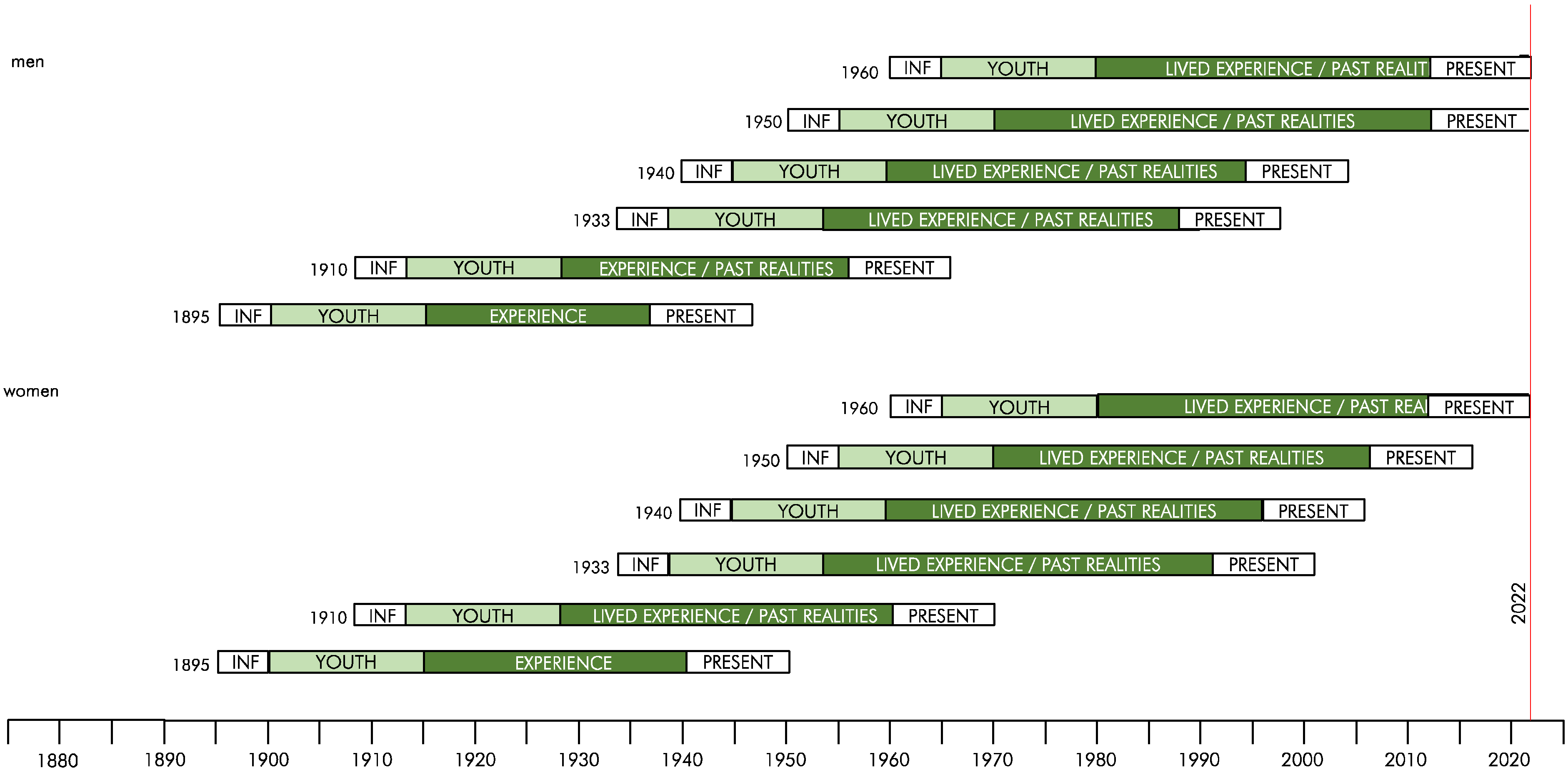


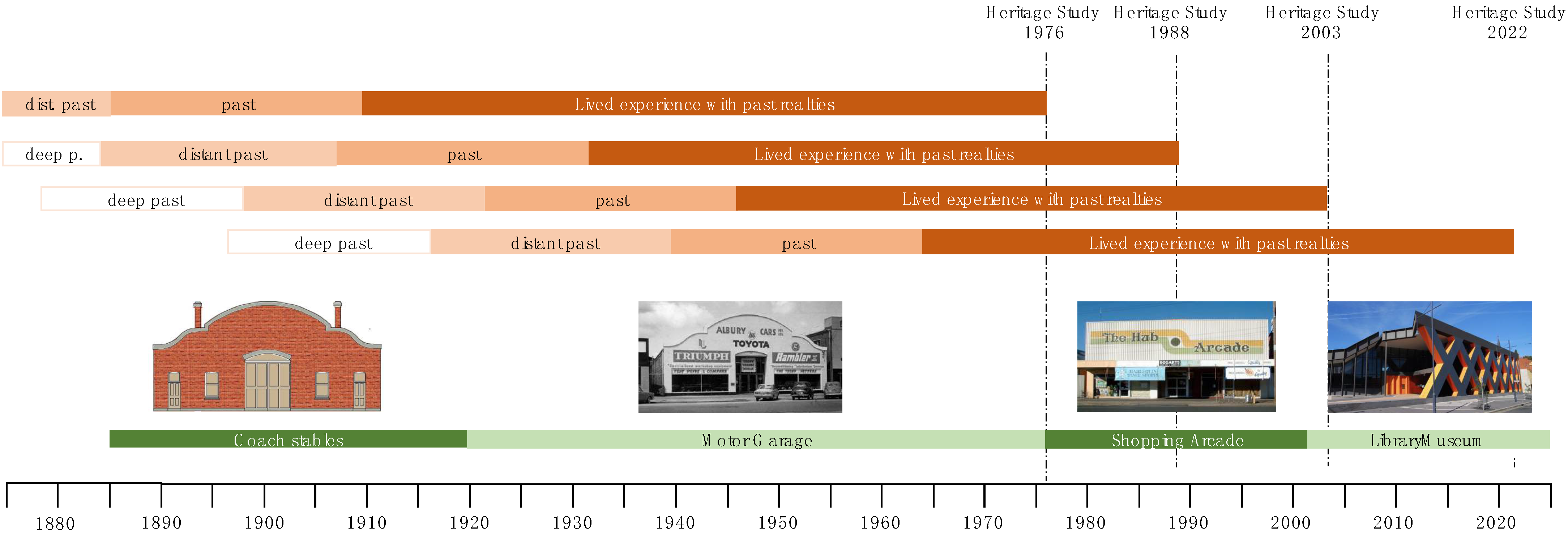

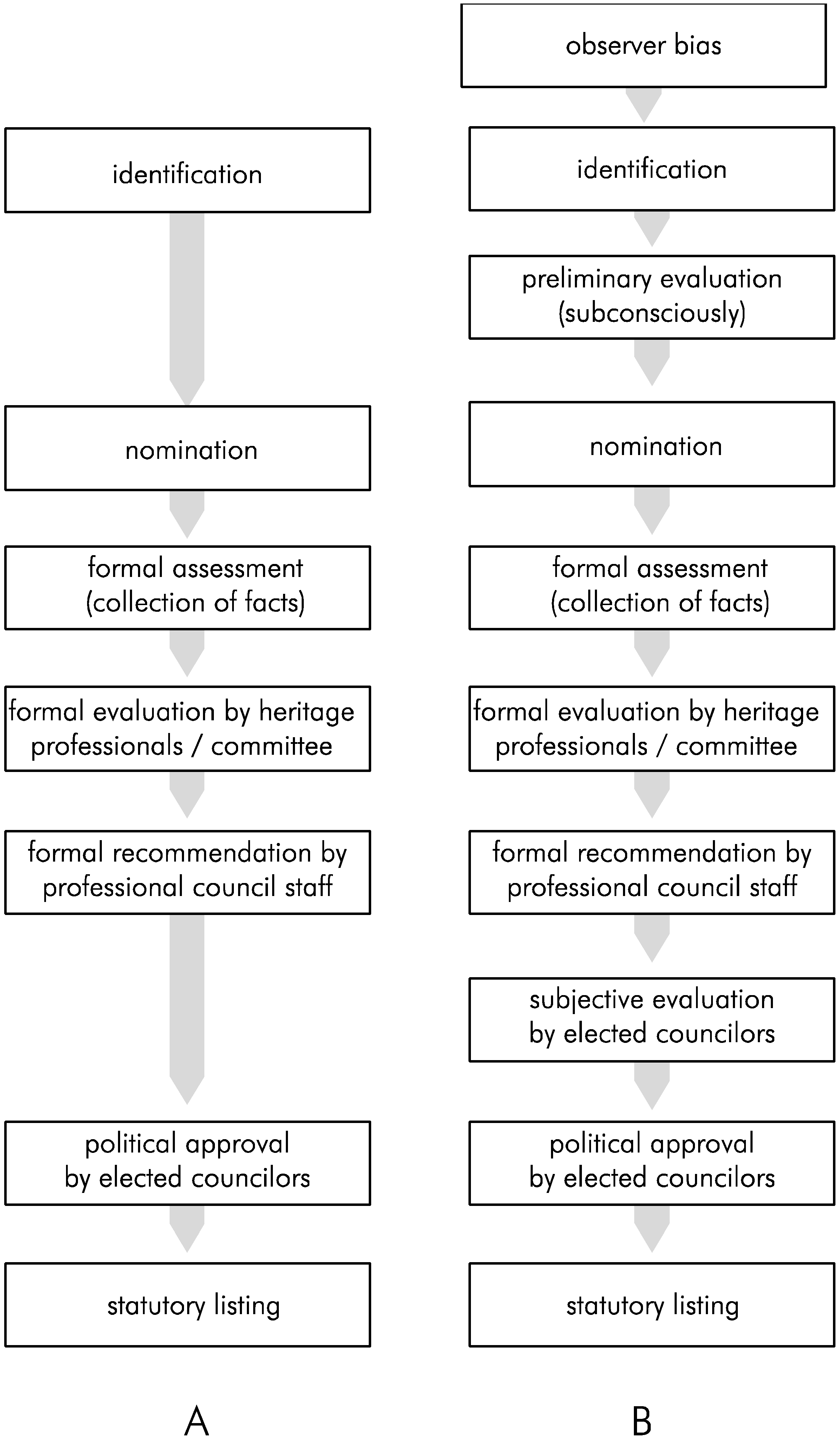
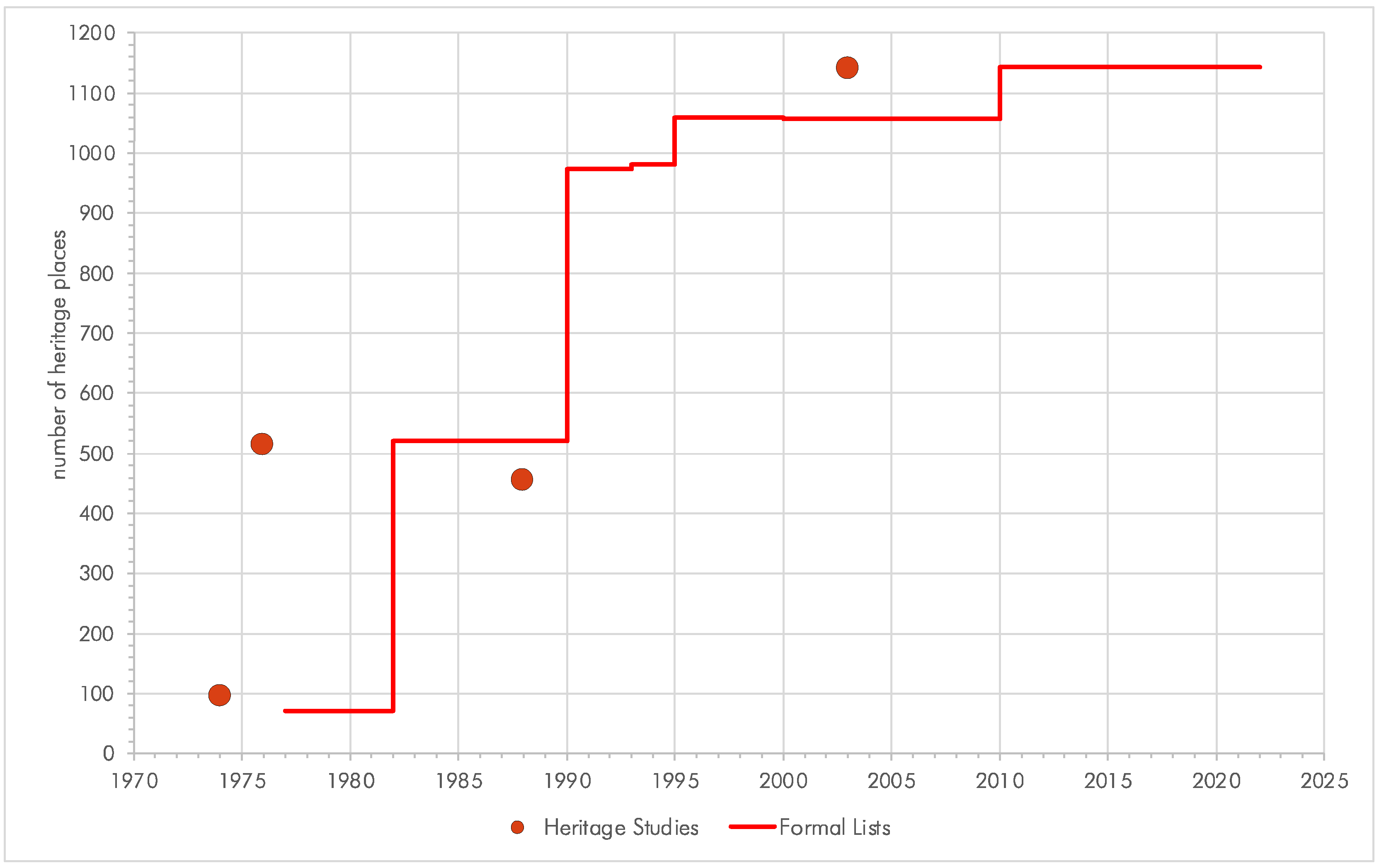

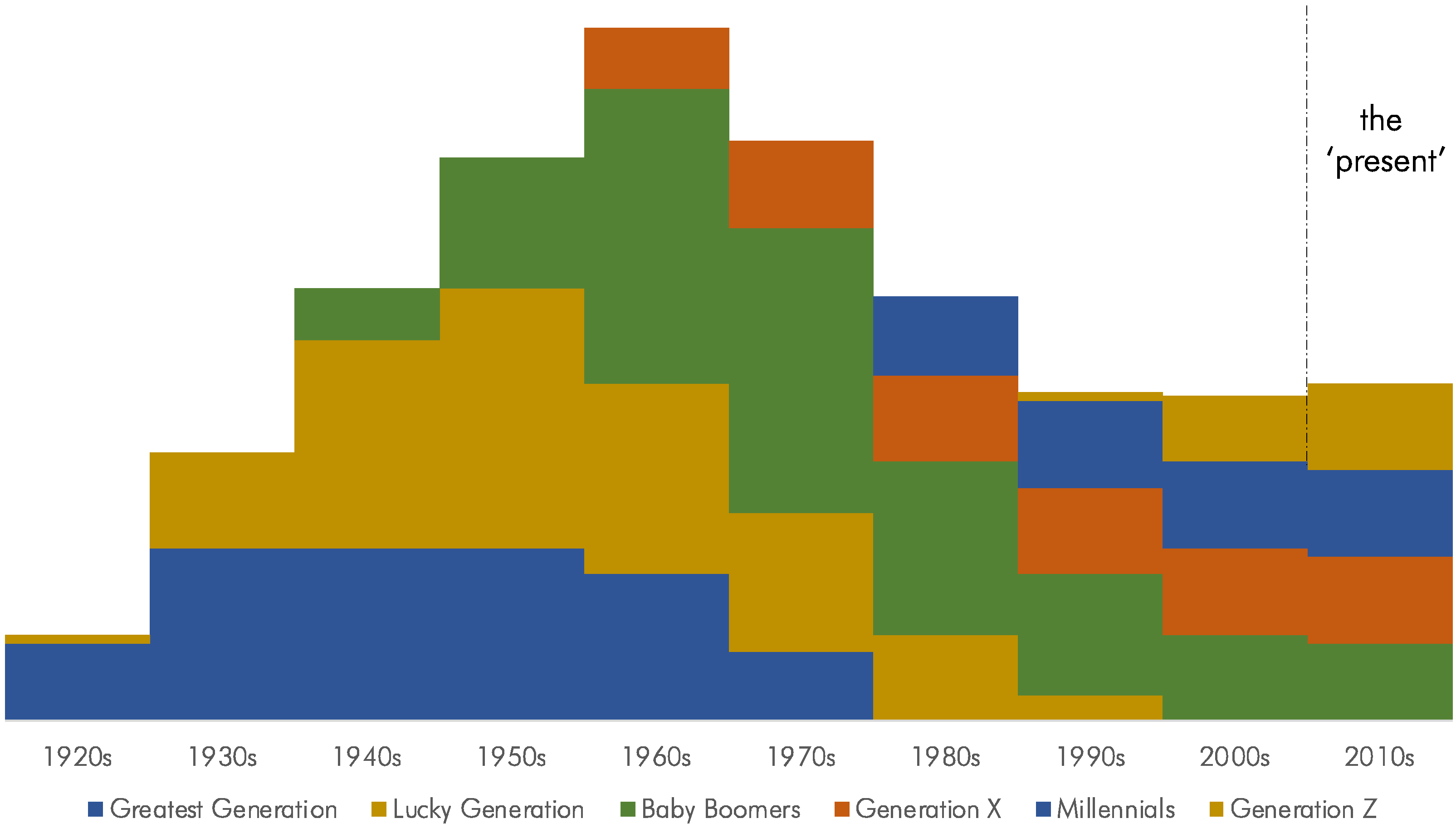
Publisher’s Note: MDPI stays neutral with regard to jurisdictional claims in published maps and institutional affiliations. |
© 2022 by the author. Licensee MDPI, Basel, Switzerland. This article is an open access article distributed under the terms and conditions of the Creative Commons Attribution (CC BY) license (https://creativecommons.org/licenses/by/4.0/).
Share and Cite
Spennemann, D.H.R. The Shifting Baseline Syndrome and Generational Amnesia in Heritage Studies. Heritage 2022, 5, 2007-2027. https://doi.org/10.3390/heritage5030105
Spennemann DHR. The Shifting Baseline Syndrome and Generational Amnesia in Heritage Studies. Heritage. 2022; 5(3):2007-2027. https://doi.org/10.3390/heritage5030105
Chicago/Turabian StyleSpennemann, Dirk H. R. 2022. "The Shifting Baseline Syndrome and Generational Amnesia in Heritage Studies" Heritage 5, no. 3: 2007-2027. https://doi.org/10.3390/heritage5030105
APA StyleSpennemann, D. H. R. (2022). The Shifting Baseline Syndrome and Generational Amnesia in Heritage Studies. Heritage, 5(3), 2007-2027. https://doi.org/10.3390/heritage5030105





